Found an old post from July , 2007 at 0ff-road.com about sleds that shaped snowmobiling… Should this list be altered at all? There have been quite a few changes in design recently, are any enough to bump a sled?
It’s summer time and lazy, warm weather lends itself to contemplation. In my case, at least, those thoughts tend to snowmobiling. For example, what impact did certain sleds have on our sport, as it exists today? How did snowmobiling get to where it is with four surviving sled manufacturers out of a once-upon-a-time 100-plus players?
Some of those players were quite significant —John Deere, Mercury Marine, Johnson, Evinrude, Suzuki, Kawasaki, Harley-Davidson— while others simply came and went largely unnoticed like Viking, Raybon, and others. Which sleds made an impact on our sport or helped shape the companies that remain?
Such thoughts made for a relaxing day on the lake as my mind wrestled with what I thought would be a good “Top 10 Most Significant Snowmobiles” over the past five decades. My main criteria and basic rule was that the introduction of these sleds should have made some major impact on the sport of snowmobiling and the companies that produced them.
Now, then, snowmobilers being snowmobilers and never sans opinions, we are certain that you have your own choices for most significant sleds. Please note that these choices are the sole responsibility of the “Rants & Raves” editor. Obviously, you are welcome to your own picks, but here are ours:
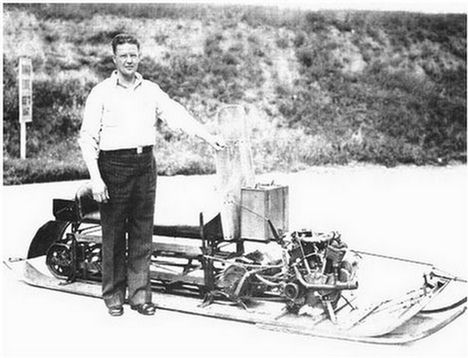 |
| Carl Eliason poses with a version of the Motor Toboggan he designed in 1924. ( Courtesy Eliason Museum, Sayner, WI) |
1. ELIASON — Pioneered concepts still seen today
In the early 1920s Carl Eliason, a storekeeper in Sayner, Wisconsin spent two-years developing an over-snow vehicle that would incorporate many of the basic concepts snowmobiles use today.
While recognized as having created a snow vehicle, Eliason seems to be oftentimes overlooked for his conceptual genius. Until I had the opportunity to have an extremely up-close look at an early Motor Toboggan a number of years ago, I too failed to recognize just how clever and ahead of his time Mr. Eliason truly was.
His first snowmobile was built in a small garage behind his general store during his spare time. He used bicycle parts for the drive train and track assembly. His first 1924 snowmobile derived propulsion from a forward-mounted and liquid-cooled 2.5 HP outboard motor. To get traction he devised a rudimentary slide rail system for a wooden-cleated track, which ran along track guides.
While he had yet to come up with a centrifugal pulley drive system, his simple solution of chain drive and geared sprockets set the tone for future designers. He simplified steering by using a rope control to turn the two wooden skis. A two-up seat was located over the track and he made running boards from a pair of downhill skis that were neatly contoured into the belly pan.
So, in 1924 we have a two-passenger snow vehicle with front-mounted, liquid-cooled engine powering a cleated track that steers via dual front runners. Ladies and gentlemen, that is the concept that is used today!
If you are curious about the evolution of the Eliason Motor Toboggans, there are currently more than 50 existing examples in private and public collections and museums throughout the USA and Canada. If you would like to see a few yourself, check out the Eliason Museum, 274 Main Street, Sayner, WI 54560 (www.eliason-snowmobile.com).
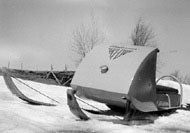 |
| Early 1959 Ski-Doo created recreational snowmobiling. |
2. SKI-DOG —First Ski-Doo started a sport and an industry
If there is any snowmobile that truly started an industry, it has to be the Ski-Doos of 1959 and the early 1960s. As most Ski-Doo fans know, the very first Joseph Armand Bombardier manufactured Ski-Doo was originally called the Ski-Dog because J-A Bombardier meant for his light-footed snowmobile to be a practical replacement for the dogsleds used by hunters and trappers.
However, more than trappers enjoyed the new vehicle. The Ski-Doo became an instant hit when the public discovered Bombardier’s speedy sleds could zip over snow and were a lot of fun. A typographical error in a Bombardier brochure changed the name Ski-Dog to Ski-Doo. Since Bombardier liked the sound of the erroneous name, he kept it and the sport of “Ski-Dooing” boomed.
What is not so well known is that in that first year, Bombardier sold 225 Ski-Doos. Just four years later 8,210 were sold. Still vividly remembering his earlier business setbacks that forced him to diversify, Bombardier initially was reluctant to focus too much on the Ski-Doo and taking resources away from his larger commercial all–terrain vehicles. He tried to slow down promotion of Ski-Doo to prevent it from dominating the other products, but the public demand for his little snowmobiles grew into an industry that was supplying upwards of 500,000 a year by the early 1970s.
Although other manufacturers of the time built snow vehicles, they tended to be cumbersome work-related vehicles. It was the Ski-Dog that caught the public’s awareness and created a new winter sport.
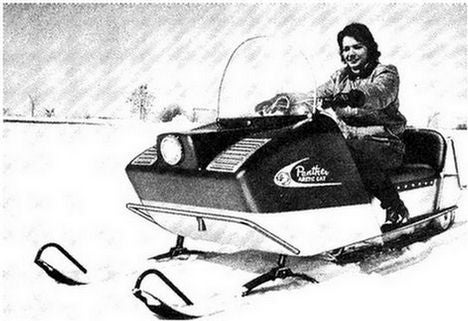 |
| The 1967 Arctic Cat Panther popularized slide rail suspensions. |
3. ARCTIC CAT PANTHER — Introduced production slide suspension
By 1967 snowmobiling was one of the fastest growing sports in the snowbelt. Innovation was at a premium as sled manufacturers sought to define themselves as industry leaders and set themselves apart form the competition. Arctic Cat in Thief River Falls, Minnesota, proved more innovative than most with its 1967 Arctic Cat Panther. It featured an easy-access flip-top hood, lightweight riveted aluminum tunnel and slide rail suspension. All in all the Panther proved quite innovative, but it is best known as being the sled that brought an emphasis on ride comfort via its slide rail technology.
With its parallel rail skidframe, the new suspension required a redesigned, three-belt, cleated track and dual drive sprockets. All of these components worked together to enhance the Panther’s overall ride and on-snow performance. It turned out that dual sprockets—which replaced the more commonly used single drive sprocket—actually transferred power to the snow more efficiently. In getting the suspension to react to bumps, Cat engineers developed a trailing arm to suspend the front of the ski frame. That concept remains a critical component in all modern slide suspensions.
With the Panther, Arctic Cat had a winner and set itself apart from competitors like Ski-Doo, Polaris and Scorpion, which retained bogie wheel suspensions and often floundered as they developed and tried various versions of their own “better” slide rail designs. Meanwhile, Arctic Cat moved forward with its slide suspension —selling more than 50,000 Panthers by 1970.
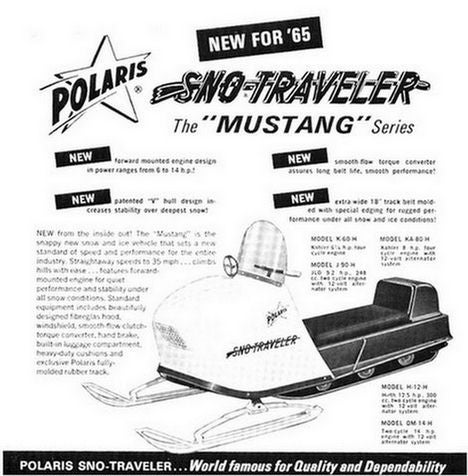 |
| The 1965 Mustang saved Polaris from being a footnote in the sport. |
4. POLARIS MUSTANG — The sled that saved a company
In researching the book—Polaris: Pioneers—it became obvious that despite the surge in snowmobiling during the 1960s, Polaris Industries nearly became a footnote in snowmobiling history. Two factors kept that from happening and set the company’s course for its current status as a worldwide leader in snowmobile technology.
By the mid-1960s Polaris was at a crossroads. One option was to throw in the towel, get out of the snowmobile business and possibly declare bankruptcy due to the abject failure of the Polaris Comet.
Retired Polaris co-founder David Johnson once told me that the Comet had only three shortcomings: “…It had an engine that wouldn’t run; a clutch and vee-belt that wouldn’t stand up; and a track that wouldn’t go in snow.”
The other option for Polaris was to hold on, ride out financial hard times, and pay back lenders while betting the company’s future on a totally new and innovative model that was readied for the 1965 model year—the Polaris Mustang.
Allan Hetteen, one of the original co-founders and president of Polaris Industries, agonized over what direction to take but ultimately he decided to risk it all on the Mustang. Fortunately, the Mustang proved to be everything that the Comet was not! The Mustang was a great success and set the tone for Polaris growth.
Where the Comet had been red and box-shaped, the new for 1965 Mustang was snow white and smoothly contoured. It looked modern, unlike the Comet, which mimicked the heavyweight, rear-engined commercial Sno-Traveler snow vehicles Polaris had built up to this point. Although bearing the “Sno-Traveler” name, the Mustang featured a front-mounted two-stroke engine and Polaris’ own drive clutch. As Allan Hetteen would say later, “…they were lightweight and they were stylish. …All of a sudden we had a machine that made winter fun.”
Polaris also had a machine that saved Polaris’ skin and hundreds of jobs in Roseau, Minnesota.
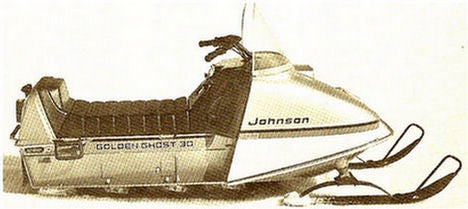 |
| The Johnson Golden Ghost brought noise reduction technology to snowmobiling. |
5. JOHNSON GOLDEN GHOST — Created sound level technologies
With the overwhelming success of snowmobile sales and snowmobilers pretty much riding anywhere they pleased, it was only natural there would be a backlash. It came in a variety of forms, but primarily consisted of three main forms: environmental concern, property rights and noise.
Environmental concerns continue to this day, as those who don’t like snowmobiles accuse snowmobilers of being responsible for all kinds of environmental damage. Property rights issues have been somewhat controlled with the advent of strong snowmobile associations and the creation of designated snowmobile rights of ways and trail systems. But noise issues were a serious concern in the early years, as those opposed to snowmobiles could easily claim that loud snowmobile noise was a problem. To alleviate those concerns snowmobile manufacturers began implementing some changes in how they designed their machines, but it was really Outboard Marine Corporation and its Johnson Golden Ghost that defined what could really be done in noise abatement.
At a time when snowmobiles routinely pegged sound meters at 83-plus decibels—or more, OMC announced that it could manufacture a snowmobile that would emit no more than 73 db. The Johnson Golden Ghost was OMC’s proof.
What is so significant about the Golden Ghost is not that it could meet lowered noise levels, which is debatable due to the varied ways of measuring snowmobile sound levels in the early 1970s, but that the methodology of its engineering created a process for others to study, follow and improve upon. OMC engineers studied four basics areas: engine mechanicals, inlet and cooling air, exhaust, and driveline.
Instituting more demanding tolerances and tightening clearances in bearings and around the cooling fan reduced mechanical noise. Enclosing the engine with a boxy cowl and limiting airflow helped reduce noise as well. This required careful engineering of the air intake into the “box” and controlling air and engine exhaust flow out of the “box.” The carburetor featured a tuned and baffled intake that controlled airflow. And the engine exhaust used a muffler for each cylinder with the outlet exiting into the track’s tunnel area to further suppress noise.
Of course, all of this attention to reducing noise levels managed to increase the sled’s weight and added complexity, which added to manufacturing costs. The Golden Ghost at $1,650 cost a bit more than conventional sports sleds of the era and at 560 pounds certainly weighed more than its competitors. But did the competition have a super-quiet sled with electric start and underseat storage?
The Johnson Golden Ghost was not a great marketing success, but it did prove that snowmobiles could be made quieter and many techniques used by OMC engineers on the Ghost are still used in today’s modern day sleds.
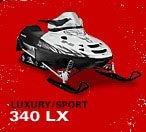 |
| Polaris’ TX-L Indy set a suspension standard that is retained in today’s Polaris models. |
6. POLARIS TXL INDY — Popularized independent front suspension
Polaris will never claim to have invented the trailing arm snowmobile suspension, but the company can claim to having popularized it in production sleds. While there have been a number of versions of an independent front suspension, most were designed for racing sleds and the names Gordon Rudolph and Indy racing car legend Bobby Unser are mentioned as innovators. In fact, it was said to be Unser who had a hand in the early Polaris trailing arm designs.
Whatever the truth may be, Polaris racing drivers of the late 1970s proved that independent front suspensions on its RX-L racers provided a winning edge in oval Sno Pro races, as the 1977-78 Polaris Sno Pro team was virtually unbeatable.
About the same time, Polaris cross country racers experimented with a version of the independent front suspension in its TX-based ”Open” class long distance racers. Adapting the unit to a TX-L and introducing it as the TX-L Indy in 1980 proved the beginning of a whole new era in snowmobiling. For Polaris the “Indy”-style front suspension that first appeared more than a quarter-century ago continues into 2008 with select models like the 550LX and Super Sport.
Although Polaris’ suspension followed Arctic Cat’s Trail Cat front end design, the Polaris design was more versatile and specifically suited for sports riding as well as the “stop and view the scenery” riding style of Trail Cat owners. The initial TX-L Indy was a direct offshoot of the leafsprung TX-L, even utilizing the popular 338cc Fuji-built twin that proved dominant in cross country racing. And the TX-L Indy introduced the “wedge” shaped nose to Polaris snowmobiles, which was a design cue for more than 20 years.
Off this chassis and suspension setup, Polaris built a reputation for handling and rugged reliability that made the company the #1 seller of sleds for more than a decade. While the competition introduced a variety of designs to supplant the Indy, Polaris evolved its design and produced one of the best selling sleds in all of snowmobiling.
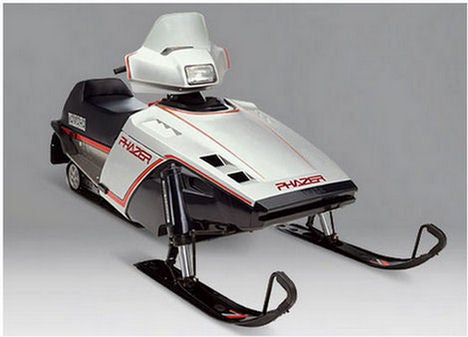 |
| The Phazer established Yamaha as the #1 selling snowmobile company. |
7. YAMAHA PHAZER — Made snowmobiling available to everyone
When Yamaha entered the sport in 1969 with its first full production snowmobile, the SL351, the company brought oil injection and slide valve carburetors as standard features. Both are still used in modern snowmobiles. But although the SL351 had a role in snowmobiling, it was the 1984 Phazer that made the more important contribution to today’s snowmobilers.
The Phazer was a successful attempt to return to light weight sleds that could power over snow rather than through it. In fact, the Phazer proved very popular in deep snow areas because it was very good in mountain snows with its combination of above average power, lightweight design, easy steering strut-type suspension and ample traction.
Another aspect that the Phazer brought to snowmobiling was an attempt to centralize the rider mass closer to the sled’s center. The Yamaha seating position moved the rider a bit forward of the rear axle and made him more the center of the see-saw action of the sled. The Phazer also introduced an aerodynamically shaped and handlebar-mounted fairing with a smallish windscreen and enclosed headlamp. It was the first production handlebar-mounted fairing since the Alouette Super Brute in the early 1970s.
Perhaps the most important aspect about the Phazer is that it helped take Yamaha to Number One in sled sales, supplanting Arctic Cat, which had temporarily gone out of business.
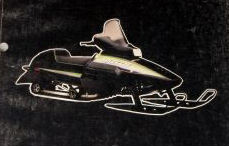
8. ARCTIC CAT PROWLER — The first true “new” Cat
By the late 1980s Arctco had resurrected Arctic Cat with pre-Arctco designs, including an A-arm front suspension that would challenge Polaris’ Indy-equipped sleds. But it wasn’t until the 1990 model year that Arctco really had a sled that represented the all-new Arctic Cat. The Prowler was the sled that brought Arctic Cat back.
The Prowler came with an all-new Suzuki-built lightweight 440cc twin that sat lower in the engine bay and that would be the base for future Cat twins. The new Cat featured a revised A-arm front end and one-piece hood. The Prowler was conceived to look high-tech while actually being less build-intensive on the production line. Like the Yamaha Phazer, the Prowler featured a handlebar-mounted fairing, but the windscreen was more effective and the headlamp was moved out of the fairing and centered on the top of the hood.
The Prowler set the stage for a new generation of Cats to follow. Built off the basic Prowler would be a line of longer-tracked touring and luxury models like a future Pantera and short-tracked performance sleds. The Prowler has to be considered the first “modern” Cat and the sled that really revived Cat loyalty to the brand. It was light in weight (435 pounds) with state of the suspension art front and rear setups that offered supple ride and long travel.
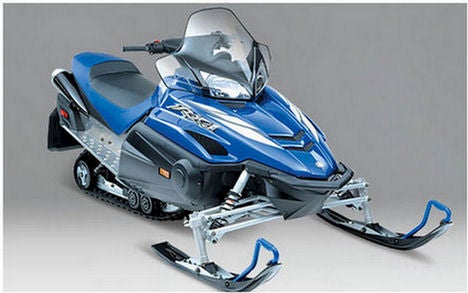 |
| The R1-derived 4-stroke provided Yamaha’s RX-1 snowmobile with a new level of 4-stroke performance. |
9. YAMAHA RX-1 — The first viable 4-stroke to snowmobiling
Yes, yes, yes, there were 4-stroke sleds before the Yamaha RX-1, but it wasn’t until the RX-1 that anyone really took 4-stroke-engined sleds seriously. It was a bit difficult not to take the 2003 RX-1 seriously because it was fast and powerful and looked very sexy.
Where previous 4-strokes had been somewhat under-powered and lumbering vehicles, the RX-1 stood out as a powerful machine. Starting with its R1 motorcycle derived four-cylinder engine, the RX-1 powerplant offered sophistication not seen before. The RX-1 featured overhead cams, high-revving power, and an engine placement that put the carb intake side forward so the quad exhaust could flow out under the seat to the rear.
Engine aside, the RX-1 came with a new front suspension style and evolved rear suspension that promised handling prowess and comfort. As Yamaha would claim, “The RX-1 delivers the optimum combination of 4-stroke performance, handling, durability and style. The RX-1 is the industry’s first 4-stroke, high-performance snowmobile.”
Consider that oil changes were seasonal and major engine tuning needn’t be done for 20,000 miles, it seemed that the RX-1 was a sled that would be fun to ride and yet be easy to live with. It certainly redefined the world of 4-stroke snowmobiling.
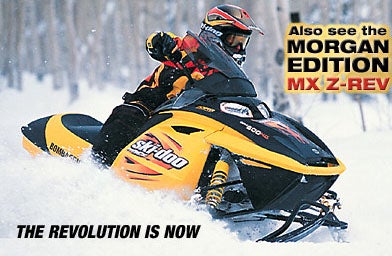 |
| Ski-Doo’s rider-forward thinking changed how sled makers designed their snowmobiles. |
10. SKI-DOO REV — Introduced ride-forward design
It was an odd-looking sled when it first appeared in 2003 and it would have an impact greater than Yamaha’s RX-1, which also appeared that season. It sat high, seemed to be a bit tippy in the rough and you could knock your knees against the cowl. It was different, and to snowmobilers used to having their backs bruised from banging over big bumps, it just didn’t seem right.
Ironically, when those riders actually got aboard the new Ski-Doo REV, they changed their minds. They discovered that this rider-forward position was exactly what they had been wanting all along. They found that the REV put their body directly at the sled’s centerpoint and that they interacted differently with this sled. It was an extremely fun way to ride. You could be a part of the action. Instead of having to grab the handlebars and pull yourself forward on the seat, you were already in the right position. Because your legs were now tucked under your body instead of being stretched out forward, you could react instantly to bumps and maneuver on the seat to move outboard in turns.
The new REV utilized a then-unique pyramidal structure to enhance chassis strength by nearly six-times the previous design. The result was a sled that was lighter, stronger, and more comfortable than its Ski-Doo predecessors. It was uniquely right for the times.
Apparently the competition felt the same way as you can see the influence the REV had on today’s rider-forward designs. Today every snowmobile manufacturer offers some version of rider-forward. That proves the point that the Ski-Doo engineers changed a sport with the REV.
HONORABLE MENTIONS
F.A.S.T. BLADE — Built by the Karpik Brothers in Eveleth, Minnesota, and despite a lack of commercial success, the Blade caused the snowmobile industry to re-think suspensions and handling criteria.
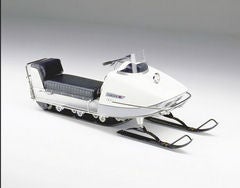
YAMAHA SL350 — This prototype Yamaha brought production oil injection and slide valve carburetors to the industry. It was one of a very few companies that virtually built all of its production sleds—including engines—from the tunnel on up.
Photo courtesy of Yamaha Marketing
JOHN DEERE SPITFIRE — A lightweight, entry-level snowmobile, it popularized snowmobiling for even beginners, and introduced the concept of a direct drive secondary in the powertrain.
SNO*JET — Perhaps because the company relied on “customer” engines from Yamaha and Kawasaki, its engineers had to come up with unique snow-ability features such as the tapered tunnel which made its sleds better able to travel in deep powder.
SCORPION BULL WHIP — Built primarily as a cross-country racing sled, this snowmobile looked great on paper with above average power and a lithesome shape. Unfortunately, it showed that on-paper technical expertise couldn’t make up for lack of on-snow capability, as it was a flop against the dominant Polaris TX-L.
Source Post: off-road.com
